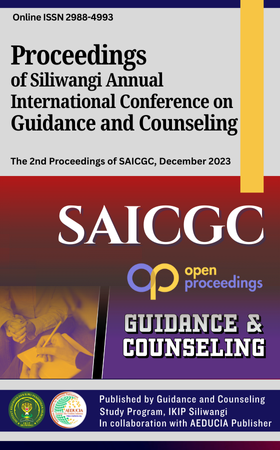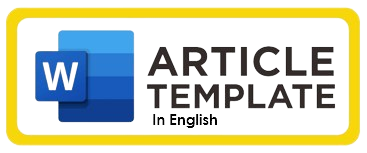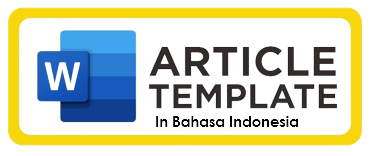Recommendations Guidance Services for Developing Self-Regulated Learning for Adolescent Students: Systematic Review of Literature
DOI:
https://doi.org/10.64420/saicgc.v2i1.49Keywords:
guidance services, self-regulated learning, adolescent studentsAbstract
Adolescents with good self-regulation skills can easily control and regulate themselves cognitively, emotionally, and behaviorally. They will complete their developmental tasks obediently, disciplined, and comply with existing rules. In addition, they will not play truant, will not create riots, and will not be late in completing their tasks. This research uses a systematic literature review method with a qualitative approach. This method aims to discover, evaluate, and interpret research results related to a particular research question, subject, or phenomenon of interest. This research's results illustrate that classical and group guidance services are considered effective interventions for students in self-regulated learning research. In the ten-year research period, there is much research on self-regulated learning in middle school to high school or teenage students.
References
Budiman, S., & Arif, M. (2017). Keefektifan bimbingan klasikal berbantuan media audio visual dalam upaya mencegah terjadinya pernikahan usia dini. Jurnal Penelitian Pendidikan Indonesia, 2 (2).
Glynn, S.M., Aultman, L.P., & Owens, A.M.(2005). Motivation To Learn In General Education Programs. The Journals of General of Education. 54 (2), 150‐170.
Harahap, D. P. (2023). Meningkatkan Self Regulated Learning pada Siswa Melalui Strategi Belajar Berdasar Regulasi Diri. Journal on Education, 5(3), 7056–7068. https://doi.org/10.31004/joe.v5i3.1494
Islami, R. (2022). Pengaruh Bimbingan Kelompok Berbasis Religius Terhadap Regulasi Diri Siswa Pada Masa Pandemi Covid 19. SECONDARY: Jurnal Inovasi Pendidikan Menengah, 2(2), 250–258. https://doi.org/10.51878/secondary.v2i2.1148
Latipah, E. (2015). Strategi Self Regulated Learning dan Prestasi Belajar: Kajian Meta Analisis. Jurnal Psikologi, 37(1), 110 – 129–129. https://doi.org/10.22146/jpsi.7696
Mukhtar, M., Yusuf, S., & Budiamin, A. (2016). Program Layanan Bimbingan Klasikal untuk Meningkatkan Self-Control Siswa. PSIKOPEDAGOGIA Jurnal Bimbingan Dan Konseling, 5 (1), 1–16.
Pujiatin, Sri, R.R. (2004). Perkembangan Self-Regulated Learning yang Diperoleh Melalui Pemahaman Bacaan dan Membuat Ringkasan pada Anak SMA. (Tesis). Program Pascasarjana, Universitas Indonesia, Jakarta.
Rahman, M. A. (2022). Strategi Bimbingan dan Konseling Kelompok dengan Teknik Modeling untuk Mengembangkan Regulasi Diri Siswa Kelas X Dan XI di SMKN 2 Garut. Edukatif : Jurnal Ilmu Pendidikan, 4(3), 4721–4732. https://doi.org/10.31004/edukatif.v4i3.2884
Sari, R. A., & Satwika, Y. W. (2022). Hubungan Regulasi Diri Dengan Prokrastinasi Siswa Di Masa Pandemi Covid-19. Character: Jurnal Penelitian Psikologi, 9 No 1, 136–145.
Siswanto. (2010). Systematic Review Sebagai Metode Penelitian Untuk Mensintasis Hasil-Hasil Penelitian (Sebuah Pengantar) (Systematic Review as a Research Method to Synthesize Research Results (An Introduction)). Buletin Penelitian Sistem Kesehatan, 13(4), 326–333.
Wangid, M.N. (2006). Kemampuan SelfRegulated Learning Pada Siswa SLTPN 1 Bantul Yogyakarta. (Disertasi). Malang. Program Pascasajana, Universitas Negeri Malang.
Wiantisa, F. N., Prasetya, A. F., Gunawan, I. M. S., Leksono, T., & Yuzarion, Y. (2022). Pengembangan Layanan Bimbingan Klasikal Berbasis Media Website Untuk Meningkatkan Tanggung Jawab Akademik Siswa. Realita : Jurnal Bimbingan Dan Konseling, 7(2), 1725. https://doi.org/10.33394/realita.v7i2.5931
Yuningdartie, Y. (2023). Efektivitas Konseling Rasional Emotif Behavioral Dalam Meningkatkan Self-Regulated Learning Siswa Sekolah Menengah Kejuruan. Jurnal Bimbingan Dan Konseling Borneo, 4(2), 1–12. https://doi.org/10.35334/jbkb.v4i2.3256
Zimmerman, B. J. (2000). Attaining self-regulation: A social cognitive perspective. In Handbook of self-regulation (pp. 13-39). Academic press.
Downloads
Published
How to Cite
Issue
Section
License
Copyright (c) 2025 Sri Agus Supriani

This work is licensed under a Creative Commons Attribution-ShareAlike 4.0 International License.
Authors who publish with this journal agree to the following terms: (1) Authors retain copyright and grant the journal right of first publication with the work simultaneously licensed under a Creative Commons Attribution-ShareAlike 4.0 International. that allows others to share the work with an acknowledgement of the work's authorship and initial publication in this journal; (2) Authors are able to enter into separate, additional contractual arrangements for the non-exclusive distribution of the journal's published version of the work (e.g., post it to an institutional repository or publish it in a book), with an acknowledgement of its initial publication in this journal; (3) Authors are permitted and encouraged to post their work online (e.g., in institutional repositories or on their website) prior to and during the submission process, as it can lead to productive exchanges, as well as earlier and greater citation of published work.

















